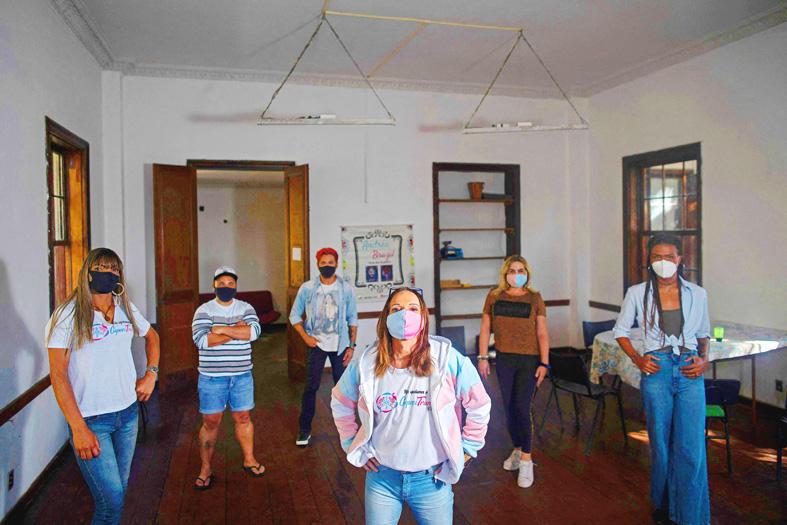For 15 years, Rochelly Rangel, 34, struggled to find a formal job in Brazil. As a transgender woman, she faced repeated rejection, insults, and once overheard a prospective boss saying: “We cannot hire a transvestite.”
She ended up working as a prostitute for six years despite having a high school technical qualification in administrative management, and also dabbled in hairdressing.
Then last year, thanks to one of a growing number of training programs aimed specifically at transgender people in famously macho and homophobic Brazil, she finally found formal employment at a bar in Rio de Janeiro.

Photo: AFP
“It was hard to get here,” she said.
Last year, 175 trans people were murdered in Brazil — one every two days. Brazil has had the world’s highest number of transgender killings since 2008.
About 90 percent of trans people in Brazil end up working as prostitutes, according to the Asociacion Nacional de Travestis y Transexuales, a gay rights association.

Photo: AFP
The life expectancy of transgender people in Brazil is about 35 years, less than half the national average.
Identifying as transgender since her teens, Rangel said that during her long and fruitless search for work, she was taking female hormones and dressing as a woman, but she was unable to legally change her male, birth name.
“I did more than 200 job interviews, but when they [looked at] my ID and resume and saw my name, they looked at me sideways or said that the vacancy was already filled,” she said.
In 2004, fresh from school, she applied for an administration post at a multinational company in Sao Paolo, where she lived at the time, and made it to the short list.
Her only rival, a young man, got the job.
“I overheard a manager tell an HR employee: ‘We cannot hire a transvestite,’” Rangel said.
Moving to Rio after several disappointments, she found the program Transgarconne run by the Federal University of Rio de Janeiro to help place transgender people in jobs at bars and restaurants.
For Rangel, her chance came at the Boleia Bar, where she works with other women.
The Transgarconne platform, started in 2019, also provides training and advice for bosses on dealing with LGBTQ+ issues.
Brazil’s biggest job platform for transgender people was born in Sao Paulo.
TransEmpregos found posts for 707 people last year, said creator Marcia Rocha, who is a lawyer and transvestite.
“We have more than 24,000 CVs and a thousand associated companies,” she said. “There has been an exponential increase in companies that hire trans people; there are more than a hundred multinationals with available posts.”
This is a useful resource in a country of 212 million — 14 million of whom are unemployed — and a service sector hard hit by the COVID-19 pandemic.
Advances for Rangel and others like her have been slow.
“It used to be thought that transsexuals could only work as prostitutes. The biggest challenge was to break this prejudice in the business environment,” Rocha said.
TransEmpregos belongs to the LGBTQ+ Business and Rights forum of Brazil, a grouping of more than 100 companies that have signed a commitment to diversity.
Unlike countries such as Argentina, where there is a legal quota for transgender people in the public sector, Brazil has no protections.
Transgender people have been able to choose their name on their ID documents without a court permission, a letter from a psychologist or proof that they are undergoing hormone treatment only for the past three years.
“We are 1 percent of the Brazilian population ... but we exist, even though they want us to be invisible,” said Andrea Brazil, a stylist and creator of Capacitrans, another trans job agency.

Former Nicaraguan president Violeta Chamorro, who brought peace to Nicaragua after years of war and was the first woman elected president in the Americas, died on Saturday at the age of 95, her family said. Chamorro, who ruled the poor Central American country from 1990 to 1997, “died in peace, surrounded by the affection and love of her children,” said a statement issued by her four children. As president, Chamorro ended a civil war that had raged for much of the 1980s as US-backed rebels known as the “Contras” fought the leftist Sandinista government. That conflict made Nicaragua one of

COMPETITION: The US and Russia make up about 90 percent of the world stockpile and are adding new versions, while China’s nuclear force is steadily rising, SIPRI said Most of the world’s nuclear-armed states continued to modernize their arsenals last year, setting the stage for a new nuclear arms race, the Stockholm International Peace Research Institute (SIPRI) said yesterday. Nuclear powers including the US and Russia — which account for about 90 percent of the world’s stockpile — had spent time last year “upgrading existing weapons and adding newer versions,” researchers said. Since the end of the Cold War, old warheads have generally been dismantled quicker than new ones have been deployed, resulting in a decrease in the overall number of warheads. However, SIPRI said that the trend was likely

BOMBARDMENT: Moscow sent more than 440 drones and 32 missiles, Volodymyr Zelenskiy said, in ‘one of the most terrifying strikes’ on the capital in recent months A nighttime Russian missile and drone bombardment of Ukraine killed at least 15 people and injured 116 while they slept in their homes, local officials said yesterday, with the main barrage centering on the capital, Kyiv. Kyiv City Military Administration head Tymur Tkachenko said 14 people were killed and 99 were injured as explosions echoed across the city for hours during the night. The bombardment demolished a nine-story residential building, destroying dozens of apartments. Emergency workers were at the scene to rescue people from under the rubble. Russia flung more than 440 drones and 32 missiles at Ukraine, Ukrainian President Volodymyr Zelenskiy

Indonesia’s Mount Lewotobi Laki-Laki yesterday erupted again with giant ash and smoke plumes after forcing evacuations of villages and flight cancelations, including to and from the resort island of Bali. Several eruptions sent ash up to 5km into the sky on Tuesday evening to yesterday afternoon. An eruption on Tuesday afternoon sent thick, gray clouds 10km into the sky that expanded into a mushroom-shaped ash cloud visible as much as 150km kilometers away. The eruption alert was raised on Tuesday to the highest level and the danger zone where people are recommended to leave was expanded to 8km from the crater. Officers also